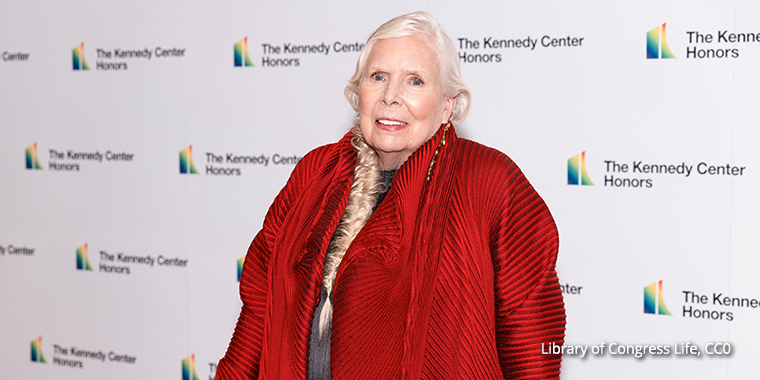Overcoming Brain Aneurysm: Joni Mitchell’s Surprise Performance

Find Your Perfect Match
Answer a few questions and we'll provide you with a list of primary care providers that best fit your needs.
For those who survive a brain aneurysm, common questions that follow include “What abilities have I lost?” and “What abilities can I recover?”
Legendary singer/songwriter Joni Mitchell, who suffered a brain aneurysm in 2015, resoundingly answered the second question with a surprise, crowd-pleasing performance at the recent Newport Folk Festival. She sang. And she played guitar, a skill she says she recently relearned by watching videos of previous performances.
Premier Health Now talked with neuroendovascular surgeon and Chair of Premier Health’s Clinical Neuroscience Institute Bryan Ludwig, MD, about Mitchell’s recovery and important facts to know about brain aneurysms.
“In recent years, about 80 percent of those with ruptured aneurysms who make it to medical care survive,” Dr. Ludwig says. He notes that a major challenge is coming to terms with long-term mental and physical limitations. Mitchell initially lost her ability to speak and walk. She still has some issues with walking.
“Most of my patients who have had a ruptured brain aneurysm will complain of memory difficulties and multi-tasking. Some have severe consequences, where one side of the body doesn’t move or they lose vision,” Dr. Ludwig says.
He agrees with other doctors that Mitchell’s ability to regain singing and guitar-playing skills is remarkable.
Understanding Brain Aneurysms
As Dr. Ludwig explains, a brain aneurysm is an area of an artery inside the skull that balloons out and weakens. An aneurysm can cause severe damage to brain tissue, and even death, if it ruptures, allowing blood to leak into the brain cavity and preventing blood from getting to brain tissue. These ruptures occur in about 35,000 Americans each year.
A ruptured brain aneurysm is also referred to as a hemorrhagic stroke, different from strokes caused by clots in the arteries.
Certain risk factors that make brain aneurysms more likely include:
- Aneurysm in a close relative
- High blood pressure or hardening of the arteries (atherosclerosis)
- Smoking
- Aging
- A previous aneurysm
- Being female
- Drug or heavy alcohol use
“If you are a first-degree relative (sibling or parent) of someone who has had a brain aneurysm rupture, I recommend getting an MRI screening of the arteries in your head,” Dr. Ludwig recommends.
How To Lower Your Risk For an Aneurysm
Although you can’t overcome your genetics or age, you can take steps to lower your risk of developing a brain aneurysm.
Dr. Ludwig says, “The big thing is seeing a primary care doctor routinely who can screen you for high blood pressure and high cholesterol. Tell your doctor if you have a family history of aneurysms. In addition, stop smoking and keep exercising.”
Classic Warning Signs
Aneurysms often have no warning signs. A rupture can cause sudden symptoms, however, including:
- A severe, sudden headache unlike previous headaches
- Neck pain
- Nausea and vomiting
- Losing consciousness
- Seizures
Treatment And Rehab
Most aneurysms are identified before they rupture through imaging studies such as CT scan or MRI performed while looking for something else.
“If the aneurysm is not very large – maybe the size of a pea – we can wait and watch, and patients do quite well,” Dr. Ludwig says. “We screen often to make sure the aneurysm isn’t growing or changing. If we determine that an aneurysm is at high risk for rupturing, we repair it.”
Dr. Ludwig says he and his colleagues most often repair ruptured and unruptured brain aneurysms with a procedure called endovascular embolization. Interventional specialists insert a catheter and wires through the wrist or groin and thread them through the artery to the area of the aneurysm. They then insert a soft metal coil or mesh into the aneurysm to reduce blood flow and prevent rupturing.
“People are back to work in three to four days after repair of an unruptured aneurysm,” Dr. Ludwig says.
In some cases, doctors apply a clip at the base of the aneurysm (a rough analogy: like using a clip to close a chip bag) to cut off blood supply to the aneurysm.
Several factors can contribute to a meaningful recovery. Dr. Ludwig notes, “Clearly, rapid and effective treatment is a big part. The support system around you, including your medical team and family, do an enormous amount. At Miami Valley Hospital, we are designated a comprehensive stroke center, with neuro teams, including a stroke team available 24/7, neurosurgeons, neurointerventionalists, neuro critical care specialists, and rehabilitation specialists.”
And, as seen with Joni Mitchell, he adds, “outlook and attitude play a huge role. Typically, recovery can happen up to a year. After a year, significant improvement is more rare and less dramatic.”
Find Your Perfect Match
Answer a few questions and we'll provide you with a list of primary care providers that best fit your needs.
Sources: Bryan Ludwig, MD, Clinical Neuroscience Institute; NPR





